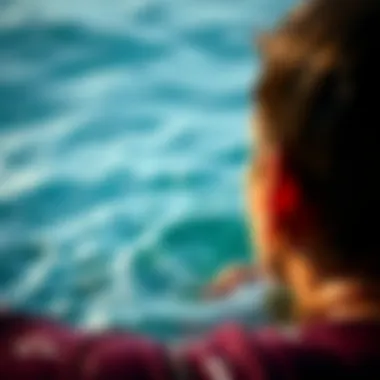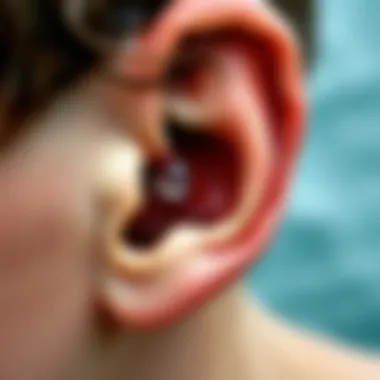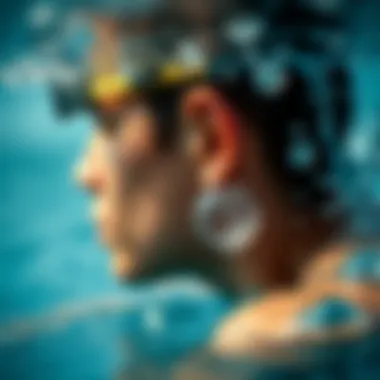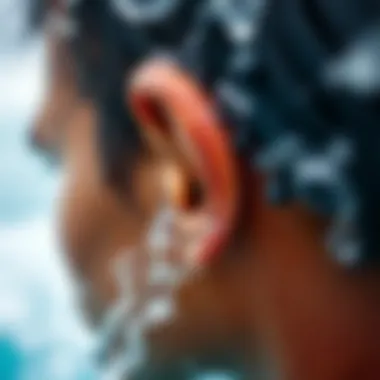Practical Ways to Remove Water from Your Ear


Intro
Water getting stuck in the ear is an all-too-familiar hassle, especially for those who love to ride the waves or dive into the deep. Whether you're a casual swimmer or a dedicated surfer, being caught in that uncomfortable situation is no picnic. Not only can it cause irritation, but it can also lead to infections if left unchecked.
Understanding the anatomy of the ear and the reasons water gets trapped is key. When you’re engaging in activities like snorkeling or kayaking, water may seep into the ear canal, making it imperative to know how to correctly get rid of it without risking damage.
This article will guide you through effective methods for getting water out of your ear, covering both immediate relief techniques and practical preventive measures. From recognizing common symptoms to safe practices, our goal is to empower you with the knowledge you need. Knowing when to seek medical help is also covered, ensuring you can take the required action when necessary.
Techniques and Skills
Fundamental Techniques for Beginners
For those starting their journey in water sports, it’s essential to have a few straightforward techniques up your sleeve. First up, the gravity method. Here's how it works:
- Tilt your head to the side with the affected ear facing downward.
- Gently tug on your earlobe to create an opening, letting gravity do its thing.
- If that doesn’t work, you can try the jaw wiggle. Open and close your mouth while tilting your head. The motion can sometimes help dislodge the water.
Another useful technique is the valsalva maneuver:
- Pinch your nose and close your mouth.
- Blow gently to equalize the pressure in your ears. Take care not to blow too forcefully.
Advanced Skills for Experienced Athletes
For those who have more experience in the water, there are nuanced techniques to alleviate ear discomfort. One effective method is ear drying drops, which can be utilized post-activity. Drops containing isopropyl alcohol mixed with vinegar can help evaporate trapped moisture. Just a few drops in the ear can make a significant difference.
When engaging in more technical sports like surfing or diving, consider investing in earplugs designed specifically for aquatic use. These are usually made from silicone, allowing you to enjoy your sport without the worry of water retention.
"Prevention is better than cure." - This idiom rings true when discussing ear safety in water activities.
Safety and Gear
Essential Safety Measures in Watersports
Safety measures are crucial not just for enjoying the thrill but protecting yourself from potential ear infections. Always rinse your ears with clean water after spending time in pools or oceans. Be mindful of how long you remain submerged, the longer the exposure, the greater the risk.
Consider regular breaks during activities. This can help ensure that your body remains acclimated and reduces the chance of water trapping incidents.
Gear Reviews and Recommendations
The right gear can make a world of difference. For those frequently engaging in water sports, swim caps or earplugs can be invaluable. Look into these recommended products:
- Mack's AquaBlock Earplugs: A popular choice that provides comfort while blocking water entry.
- Swim Ear Drying Aid: A specialized solution that offers quick relief from water retention.
Before buying, do some research on user reviews on platforms like Reddit or Amazon, as they often provide insights from fellow water enthusiasts.
In summary, knowing how to deal with water trapped in your ear is vital for those who love water-based activities. Employing proper techniques, using specialized gear, and minding safety protocols can help you enjoy your time in the water to its fullest without the discomfort later on. Educating yourself on these matters ensures that you’re prepared for every adventure that comes your way.
Understanding the Issue
Water trapped in the ear is more than just an annoyance; it can lead to discomfort and even health complications if not addressed properly. Understanding the issue is paramount to managing it effectively, particularly for those who frequently engage in water-related activities like swimming, diving, or surfing. When water enters the ear canal, it can cause a sensation of fullness and even temporary hearing loss. But why does this happen?
Anatomy of the Ear
To grasp why water gets trapped, it's essential to know a bit about the anatomy of the ear. The ear comprises three main parts: the outer ear, the middle ear, and the inner ear. Sound waves funnel through the outer ear, hitting the eardrum situated between the outer and middle section. This drum vibrates, aiding sound transmission.
The ear canal is lined with skin and glands that produce earwax, which protects the ear from bacteria and foreign objects. However, the shape of the ear canal, which curves and may have natural constrictions, can easily trap water when submerged. As a result, it’s common for athletes and weekend warriors alike to experience this all-too-familiar feeling of water lingering long after exiting the water.
Why Water Gets Trapped
There are several reasons water might find its way into the ear and refuse to leave. First, the ear canal's unique shape and structure can create small pockets where water can accumulate. This is especially evident in individuals with earwax build-up, which may prevent water from draining out effectively. Moreover, engaging in activities like swimming and diving increases the likelihood of exposure to water, often leaving little time to remove it before it becomes trapped.
Another contributor is physiological responses. When water enters the ear, it might lead to the eardrum expanding, making it more difficult for fluid to escape. Stress from rapid changes in pressure, particularly when diving or experiencing waves while surfing, can also heighten this risk.


Common Symptoms of Water in the Ear
Symptoms of water trapped in the ear usually present themselves clearly but can often be confused with other ear-related issues.
- Fullness or pressure: A common sensation reporting feeling of pressure, like having a plug lodged in.
- Hearing changes: Sounds may seem muted, as though underwater; everything may feel distant.
- Discomfort or pain: Prolonged water exposure can lead to irritation, ranging from mild discomfort to significant aches.
- Itchiness: The presence of moisture may create an itchy feeling, drawing continuous attention to the ear.
If you notice these symptoms, it’s essential not to ignore them. Prolonged exposure to trapped water can lead to infections, like swimmer's ear. Recognizing these signs is an essential step in practicing good ear health, especially for water sports enthusiasts. Keeping these factors in mind will aid in promptly identifying and addressing the issue.
Immediate Techniques for Water Removal
The discomfort of water trapped in the ear can be a frustrating experience, especially for those who engage in water activities. Immediate techniques, therefore, become vital for relief, not just for comfort but also to prevent potential ear infections or further complications. These methods are simple, quick, and very useful for anyone looking to resolve this nuisance. Let's delve into some of these techniques that can provide instant help.
Gravity Method
The Gravity Method is one of the most straightforward approaches to draw water out of the ear. It hinges on the principle that, with the right positioning, gravity can aid in the removal.
Tilting the head
Tilting the head is perhaps the most common technique under the Gravity Method. By pulling the affected ear downward, any trapped water can flow out more easily. The important characteristic of this method is its absolute simplicity—there’s no need for specialized tools or expertise.
A unique feature of tilting the head is that it can be done anywhere at any time. It provides a simple solution right at your fingertips. However, one downside is that it may not work for everyone, especially if the water is trapped too deeply or if there are anatomical snags. Still, for many, this method is often the first line of defense.
Jumping on one foot
Jumping on one foot may sound a bit quirky, but it’s a surprisingly effective technique. By combining gravity with a bit of movement, this method can shake loose any stubborn water. The key characteristic here is the rhythmic motion, which can help create a shift in pressure.
One reason people find this method beneficial is that it can be done playfully—like a game, especially for kids. However, there's a catch: it can look a bit silly in public! Also, for those with balance or mobility issues, it might not be the best choice.
Valsalva Maneuver
The Valsalva Maneuver utilizes a specific technique involving controlled breathing to equalize pressure in the ear. This is particularly useful if water is making the ears feel clogged.
How to perform the maneuver
That said, it’s crucial to be gentle. Over-straining during the maneuver can lead to discomfort or even more serious ear issues.
Cautions and recommendations
While performing this technique, there are certain cautions to consider. It’s advisable not to try this method if experiencing any pain or if there’s a known ear condition. The important recommendation here is to consult with a healthcare professional before attempting the Valsalva Maneuver, particularly if there’s a history of ear issues. Ignoring this could lead to complications, turning a simple nuisance into a more significant issue.
Using a Hair Dryer
Using a hair dryer might strike some as a creative solution, but it is based in logic. The warm air can help evaporate the trapped water effectively.
Optimal settings
For those willing to try, it's essential to pick the optimal settings on the hair dryer. Using a low heat setting ensures that the warmth does not cause burns or damage to the ear. This method is appealing largely because it combines comfort with efficiency, letting the heat work its magic without any harshness.
However, over-relying on heat can result in discomfort due to overheating. Care should always be taken to maintain a reasonable distance.
Distance from the ear
Keeping the hair dryer at the right distance from the ear while using it is crucial. A safe distance, generally around a foot, helps prevent direct heat exposure, which could be harmful. This characteristic of using a hairdryer method is that it offers a more gradual approach to drying out the ear.
But users should be cautious—getting too close can lead to burns or irritation. So while this method is practical, it’s imperative to keep safety in mind.
Creating a Vacuum Seal
Creating a vacuum seal is another interesting method that some find helpful for removing water from the ear.
Method description


This technique can involve the use of a few different approaches, such as cupping the palm over the ear and pressing it inward to create a vacuum. The suction created can sometimes pull out the water effectively. Its effectiveness is largely due to the fact that it makes use of physics, employing suction to change the pressure around the ear, allowing trapped fluids to escape.
On the flip side, it may require some practice to get it right, and not everyone may have success.
Precautions
While this method can provide quick relief, there are also important precautions to keep in mind. For starters, it’s vital not to apply excessive pressure, which can lead to pain or injury. The key characteristic of this preventive measure is the need for care and finesse. Trying to force water out can lead to potential harm, so take this method lightly.
Hydrogen Peroxide Technique
Hydrogen peroxide can serve as a dual function in this context—not just for cleaning but also for breaking down the moisture in the ear.
Strength and application
Using hydrogen peroxide effectively means opting for a diluted solution—usually around 3%. Applying a few drops can help with loosening any debris or water. The appeal of this method lies in its effectiveness, as the effervescence generated helps lift trapped fluid. The technique has gained traction due to its potency and ease of application.
However, overly strong concentrations can cause irritation, so it’s essential to stick to recommended strengths.
Debunking myths
A few myths surround the use of hydrogen peroxide. Some believe it can permanently damage the ear or that it is dangerous when used improperly. The key characteristic to note here is the necessity of following guidelines closely. When used correctly, hydrogen peroxide can be a beneficial tool. However, misinformation might create undue fear and lead people to avoid effective methods.
In summary, the immediate techniques for relieving water from the ear offer various options, from employing gravity to utilizing common household items safely. They provide a practical array of choices, allowing individuals to find what works best for them. While these techniques are capable of quick relief, remaining vigilant about safety and technique ensures effectiveness and minimizes risks.
Long-term Prevention Strategies
Engaging in water activities brings a wealth of enjoyment, but it can also lead to unwanted water trapped in the ear. To preemptively tackle this quagmire, implementing long-term prevention strategies is imperative. These methods not only help in maintaining comfort during and after water exposure but also ensures overall ear health. By adopting effective protection, proper techniques, and regular care, enthusiasts can sidestep the woes of water retention and its potential complications.
Ear Protection in Water Activities
Diving caps
Diving caps are a purposeful countermeasure against water intrusion. Their distinctive feature lies in their snug fit, designed to cover the ears and create a barrier against water. They are popular among both divers and swimmers, serving the dual purpose of protecting the ears and keeping hair dry.
The key characteristic of diving caps is their material, usually made from silicone or nylon, which ensures not just coverage but comfort as well. Their benefit lies in providing a simple, effective way to keep water at bay, minimizing the risk of infections or discomfort from trapped water. However, they may feel restrictive for some users, and won't be suitable in every situation.
Swim earplugs
Swim earplugs provide another layer of defense against ear water ingress. Their primary role is to plug the ear canal, thus obstructing unwanted fluid from entering. They come in various designs, including custom-fit options and generic models, catering to different preferences.
The standout feature of swim earplugs is their adaptability. Many models are reusable, made from soft materials like silicone, and they can fit snugly without causing discomfort. This can be a significant advantage for those frequently in the water. Still, there’s a downside; not all earplugs seal effectively, and poorly designed ones can fall out during vigorous activities.
Proper Techniques for Watersports
Exiting the water
How you exit the water can influence whether water ends up in your ears or not. Taking a moment to do this carefully can make all the difference. Ideally, when getting out of the water, you should turn your head to one side so any trapped water can flow out. This technique ensures gravity aids in the process, promoting a smooth transition.
The main characteristic of this method is its simplicity; there's no need for tools or advanced techniques, which makes it quite user-friendly. While it's effective for many, it might not help every water enthusiast, especially if water has been trapped for extended periods.
Shaking water out
Shaking your head to dislodge trapped water can be surprisingly effective. As natural as it sounds, this technique encourages movement within the ear canal, prompting water to escape. When combined with an appropriate tilt of the head, this method can yield quick results.
The distinct trait of this technique is its immediacy; it can be performed on the spot without any prior preparation. It’s particularly advantageous for quick fixes during or immediately after water activities. On the flip side, shaking can be ineffectual if water is stuck deep in the ear.
Regular Ear Cleaning
Safe practices
Maintaining ear hygiene is vital for preventing water retention issues. Safe practices include using gentle methods for cleaning the outer ear, such as a warm washcloth. It's crucial to avoid inserting objects like cotton swabs deep into the ear canal, as they can push wax and debris further inside, potentially leading to blockages.


The importance of safe practices cannot be overstated, as improper cleaning can lead to infections and other complications. A key benefit is that regular cleaning can keep earwax at manageable levels, reducing the likelihood of traps. Of course, this demands consistency and a conscientious approach.
Recommended tools
Utilizing recommended tools enhances ear hygiene. Items such as ear irrigation syringes or saline solutions can help keep the ear canal clean. Many people find bulb syringes to be an effective means of gently flushing the ear with a safe liquid.
These tools stand out because they are specifically designed to reach places that might be difficult to clean otherwise. Their primary advantage is that they allow for thorough cleaning without risk of causing damage like might occur with sharp objects. However, they do require a level of comfort and experience to be employed safely.
Understanding Your Ear Health
Consulting with professionals
For water sports enthusiasts, consulting with professionals is invaluable. Audiologists or ENT specialists provide insights into maintaining ear health, especially for those prone to problems. Moreover, regular check-ups can preempt potential issues before they escalate.
The key character of this approach is proactive management of ear health; it’s far better to address concerns early than to wait for symptoms to manifest. The advantage here is gaining tailored advice specific to individual needs and conditions, along with peace of mind. However, while regular visits are beneficial, they may not always be feasible for everyone due to various constraints.
Recognizing underlying conditions
Being aware of underlying ear conditions can be a game changer. Some individuals may have natural variations in ear anatomy or previous issues that predispose them to water retention. Recognizing these factors can help in tailoring appropriate strategies for prevention and management.
The focal point of this recognition is to gain insight into personal ear health, which plays a significant role in one’s ability to withstand water-related activities. An advantage here is improved awareness can guide individuals in seeking timely assistance or making informed decisions about their participation in water sports. However, this knowledge can induce a certain level of concern in some, promoting a cautious approach.
When to Seek Medical Attention
Getting water stuck in your ear is like that pesky itch you just can’t scratch - it lingers. While many incidents resolve themselves quite easily, there are times when the best course of action is to reach for your phone and call a healthcare professional. Understanding when to seek medical attention can make all the difference in preventing further complications.
When you notice something’s not right with your ears after a water-filled adventure, consider specific elements like symptoms and duration before deciding your next steps. The key is recognizing the signs that indicate a more serious issue at play. If you ignore them, you might find yourself in a world of trouble later on.
Signs of Infection
If the discomfort from water trapped in your ear doesn’t let up after a few minutes, it’s time to pay attention. Look out for symptoms like:
- Persistent pain: If your ear feels like it's throbbing or if the pain intensifies rather than lessens, take it seriously.
- Discharge: Any fluid or discharge that is not just water, especially if it’s colored or has an odor, could be a red flag.
- Fever: If you're running a temperature, it’s a strong indication that an infection could be setting in.
- Hearing changes: Sudden or gradual loss of hearing may hint at something more serious.
If you spot any of these symptoms, don’t just brush it off. As the saying goes, better safe than sorry. Early detection is crucial to heading off infections that could lead to more extensive medical interventions.
"Don’t let a little water turn into a tidal wave of trouble."
Persistent Symptoms
Should you find that discomfort remains despite your best efforts, or if you experience returning issues with water retention, don’t hesitate to consult a healthcare professional. Persistent symptoms can include:
- Ongoing discomfort: If you still feel full or clogged even after trying various home techniques, it’s a signal.
- Chronic earache: Continuing pain, especially if it's a regular occurrence, should prompt an evaluation.
- Balance issues: Having trouble with balance or feeling dizzy? Issues like these can indicate pressure build-up or an underlying problem.
These symptoms can indicate something beyond just water being trapped, as they can be associated with conditions such as otitis media or even eustachian tube dysfunction. Knowledge is power - understanding when symptoms cross from annoying to concerning can save you significant trouble down the line.
Ultimately, your ears are important. Taking the steps to protect your ear health during and after water activities, while knowing when to seek help, is crucial for anyone engaged in water sports or just enjoying the great outdoors.
The End
In wrapping up this article, it’s crucial to understand the significance of effectively dealing with water trapped in the ear, especially for those who engage in water sports. The complications arising from trapped water extend beyond mere discomfort; they can escalate into infections and long-term ear health issues if not managed promptly. This guide provided an overview of various effective techniques for immediate relief and outlined preventive strategies that can diminish repetitive occurrences.
Recap of Techniques
Let’s take a moment to recap the core techniques presented:
- Gravity Method: This includes tilting the head and utilizing movement to help the trapped water escape.
- Valsalva Maneuver: A technique that involves a controlled breathing method to equalize pressure, potentially expediting water removal.
- Using a Hair Dryer: A simple yet effective way to ease moisture by directing warm air safely from a distance.
- Creating a Vacuum Seal: A method that utilizes suction to help pull water out, but not without precautions to ensure ear safety.
- Hydrogen Peroxide Technique: This involves using a safe concentration of hydrogen peroxide to facilitate drainage while debunking popular myths around its use.
These techniques each have their unique benefits and should be selected based on what is most comfortable and appropriate for the individual’s situation.
Final Thoughts on Ear Health in Water Sports
Awareness is your best ally. For water sports enthusiasts, keeping ear health in check is as essential as checking equipment before a dive. Regular practice of preventative methods, alongside an understanding of what to do when water does get trapped, can make all the difference.
Maintaining ear health doesn't just enhance your enjoyment of water activities; it also safeguards against potential complications that can spoil future outings. Always remember, if you find yourself frequently dealing with discomfort or water retention, consulting a healthcare professional is advisable. Keeping dialogue open about ear health ensures that your adventures remain both enjoyable and safe.
Always act swiftly when dealing with ear issues; what starts as a minor inconvenience can turn into something more significant if ignored.















